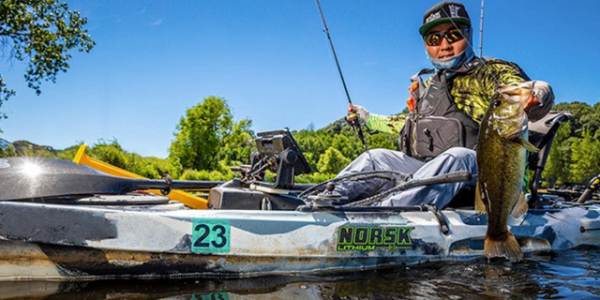Know The Difference: Invasive Versus Common Carp






There’s a lot of talk around the Great Lakes these days about carp, especially invasive or Asian carp. What about common carp, those monsters of Michigan waters anglers love to battle with fly rods? Are these fish one and the same and what’s the big deal about carp anyway?
The issue can be confusing.
To better understand the important differences, it’s best to start with a definition of what an “invasive” species is.
“Invasive species are those species which are not native to a particular area – in this case Michigan – and whose introduction causes harm or would be likely to cause harm to the state’s economy, human health or environment,” said Joanne Foreman, communications coordinator for the Michigan Invasive Species Program.
Just because a species is not native does not make it invasive.
“Whether fruits, vegetables, livestock or field crops, most non-native species are not harmful and many provide benefits to Michigan, from boosting the economy to beautifying landscapes,” said Nick Popoff, head of the Michigan Department of Natural Resources’ Aquatic Species and Regulatory Affairs Unit. “When it comes to fish, some non-native species beneficial to Michigan through sportfishing enjoyment have included coho and Chinook salmon and brown and rainbow trout.”
Invasive species are those particular non-natives that pose potential harm.
As the name “invasive” suggests, these species can out-compete native species by reproducing and spreading quickly in areas where they have no natural predators, thereby changing the balance of the ecosystems Michigan relies on for recreation, commerce, food and jobs.
Means of introduction
From the emerald ash borer and sea lamprey to rusty crayfish and Eurasian watermilfoil, numerous invasive species have found their way to Michigan, often by interesting means.
Some traveled here in the ballast water of ships. Others escaped from pet stores or were household pets let go into the wild where they adapted to local conditions. Still others hitched rides on planes, trains and automobiles.
In the case of all carp species, they intentionally were introduced to North America.
Common Carp
Common carp were brought to the United States during the late 1800s as an esteemed food of European and Asian markets. Native to Eurasia, common carp are found today in the Great Lakes, large inland lakes and reservoirs, small and large rivers, swamps, canals and drains. Many frequent places where water quality is less than ideal.
An increasing number of sport anglers enjoy battling these fish and some charter operators now offer carp excursions.
Common carp average 15 to 32 inches and 4 to 31 pounds. They have triangular heads, blunt snouts and small barbels (fleshy, whisker-like filaments) at the corners of their mouths.
Because they have been widely distributed and their demand as a food source has diminished, common carp sometimes are referred to as a nuisance species. However, they are not considered invasive in Michigan.
Invasive carp
There are four carp species that are described as invasive – bighead, silver, grass and black.
In the 1970s, invasive carp were brought to the U.S. from Asia, primarily to eat algae in the ponds of aquaculture operations located in the South. During flooding events, these fish escaped into the Mississippi and Illinois rivers and have been migrating north toward Lake Michigan.
Because the invasive carp problem is a binational and multistate issue, U.S. federal and state governments are working together with Canada on a resolution.
The U.S. Army Corps of Engineers, in a partnership with state and federal agencies, has erected electric barriers in the Chicago Area Waterway System and a berm in Indiana to try to keep the carp from reaching the Great Lakes.
The Michigan DNR is among the leading agencies advocating for additional efforts to stop the spread of these fish.
The watch list
Michigan maintains a “watch list” for invasive species. Species on the watch list have never been confirmed in the wild in the state or have very limited distribution. If they are encountered, they should be reported as soon as possible.
“Early detection and timely reporting of these species are crucial for increasing the chances of preventing establishment and limiting potential ecological, social and economic impacts,” Foreman said.
Bighead, silver, grass and black carp are on the watch list. They also are “prohibited” invasive species in Michigan.
Prohibited and restricted species
Some invasive species are legally designated by the state of Michigan as either “prohibited” or “restricted,” making them unlawful to possess, introduce, import, sell or offer for sale as live organisms, except under certain circumstances.
• The term “prohibited” is used for invasive species that are not widely distributed in the state. Often, management or control techniques for prohibited species are not available.
• The term “restricted” is applied to invasive species that are established in the state. Management and control practices usually are available for restricted species.
Michigan’s Natural Resources Environmental Protection Act (Part 413 of Act 451) established the list of prohibited and restricted species, which is regularly amended by Invasive Species Orders.
Bighead and silver carp
Of the four invasive carp species on the watch list, bighead and silver carp pose the most concern.
“Bighead and silver carp are spreading to lakes, rivers and streams in the Mississippi River and Great Lakes region. They have been moving steadily north, but are not yet established in the Great Lakes,” said Seth Herbst, a fisheries biologist and the DNR Fisheries Division’s aquatic invasive species coordinator. “These two species like large lakes and connecting rivers, and if introduced would have the ability to adapt to Michigan’s cold winters.”
Biologists expect that if these invasive carp make it to Michigan waters, the fish will disrupt the food chain that supports native fish of the Great Lakes, such as walleye, yellow perch and lake whitefish – which could diminish fishing opportunities for sport and commercial anglers.
“Due to their large size and rapid rate of reproduction, bighead and silver carp pose a significant threat to the ecosystem of the Great Lakes Basin,” said Tammy Newcomb, DNR senior water policy advisor and fisheries research biologist. “Silver carp leap high out of the water when disturbed by watercraft. Boaters can be and have been injured by these leaping fish. Fear of injury could diminish the desire for recreational boating activities in areas inhabited by these fish.”
Bighead and silver carp have eyes situated below their toothless mouths. Silver carp may grow to longer than 3 feet and weigh up to 60 pounds, while bighead carp are even larger – up to 5 feet long, weighing up to 90 pounds.
Adult bighead carp are dark gray, with dark blotches. As the name implies, silver carp are silver colored with white bellies.
Black carp
Black carp are the largest of the four invasive carp species. They can be over 6 feet long and weigh more than 150 pounds. These fish have blackish-brown-bluish scales and an almost white belly.
So far, bighead, silver and black carp have not been found in Michigan waters. There is no evidence that these three carp species have colonized or are present in any numbers in the Great Lakes.
Grass carp
“Grass carp have been detected in low numbers in all the Great Lakes, except Lake Superior, since the early 1980s (Lake Erie in particular) and have historically been introduced into waterways for aquatic nuisance vegetation control in some Great Lakes states,” Popoff said.
Grass carp can grow to more than 5 feet long and weigh more than 80 pounds. They have eyes that sit in line with their mouths, or slightly above, and scales that look to be crosshatched.
“In the mid-1980s, a grass carp sterilization program was put in place to reduce the risk of introduced fish reproducing and reaching nuisance levels that would result in detrimental impacts,” Herbst said. “The sterilization program has worked to some extent, but fertile fish are still being captured in locations where only sterile fish introduction is authorized.”
Despite the reduced threat of grass carp, Michigan is still taking a proactive approach with regulations, enforcement, and using a scientific approach to increase the effectiveness of control efforts.
Knowing the difference between common and invasive carp is not as difficult as it might seem at first, once you know the facts.
“Educating ourselves and others on these species can go a long way in the fight against the proliferation of these non-native, invasive species of carp – fish that have the potential to dramatically damage or destroy Great Lakes ecosystems, causing untold losses to Michigan’s economy and world-class natural resources,” Foreman said.
Watch Michigan DNR staff training to catch invasive carp in Illinois.
Report invasive (Asian) carp and get more information on invasive species. Find out more about the history of common carp in North America.
Catch upcoming stories by subscribing to free, weekly “Showcasing the DNR” articles. Check out previous Showcasing articles.






